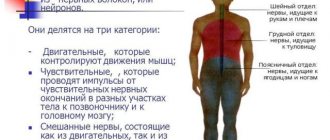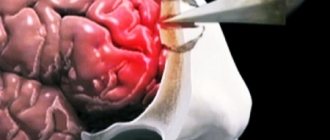Causes of coma
Coma is not considered an independent pathology; in medicine it is defined as a severe complication of the central nervous system, the basis of which is damage to the nerve pathways.
As is known, the cerebral cortex is capable of receiving signals emanating from the environment through the so-called reticular formation, which is directed through the entire brain. It will be a filter that systematizes and passes through nerve impulses of various types. If the cells responsible for the reticular formation are damaged, there is a complete loss of communication between the brain and the environment. The patient falls into a coma.
Damage to nerve fibers occurs both due to physical impact and due to the influence of chemicals. Physical damage can even occur with strokes, traumatic brain injuries, cerebral hemorrhage and other injuries.
As for the chemicals that cause a comatose state, these include:
- internal (products of metabolic processes formed as a result of pathologies of internal organs);
- external (entering the body from the environment).
Internal damaging factors include: a decrease in oxygen levels in the blood (also called hypoxia), low or high glucose levels, the presence of acetone bodies (which is often found in diabetes mellitus) or ammonia (in the case of severe liver diseases).
If we talk about external intoxication of the nervous system, it occurs in the case of an overdose of narcotic substances or abuse of sleeping pills, as well as in case of poisoning with neurotropic poisons. Interestingly, the external type of intoxication can also be caused by the action of bacterial toxins, which is often observed during the spread of infectious diseases.
The most common cause of coma will be a combination of signs of chemical and physical damage related to the reticular formation. This is expressed in a characteristic increase in intracranial pressure. The latter is often observed in cases of traumatic brain injury or brain tumors.
Causes of coma and its types
The reasons for the development of comas are quite diverse - from foci of necrosis or hematoma to metabolic, hypoxic diffuse damage. The most common reasons are:
- areas of hemorrhage, cerebral infarction due to hypertension, atherosclerosis, diabetes, aneurysms or vascular malformations;
- brain abscesses;
- neoplasms;
- traumatic head injuries;
- prolonged epileptic seizures, epistatus (diffuse non-structural changes against the background of cerebral edema and necrosis of individual neurons);
- severe somatic diseases: renal failure (uremic coma), liver damage (hepatic encephalopathy), diabetes mellitus (diabetic coma);
- disorders of electrolyte metabolism (increased levels of calcium, sodium, carbon dioxide in the blood, etc.);
- alcoholic brain damage (Haye-Wernicke encephalopathy);
- infectious diseases with brain damage (encephalitis, meningitis);
- poisoning with drugs (psychotropics, sedatives, etc.), carbon monoxide.
Figure: pathogenesis of coma development
There are several dozen types of coma based on the reasons that cause them . Some of them are independent diseases, others are manifestations of some pathology. There are:
- Primary cerebral coma - this group includes traumatic coma with head injuries, epileptic, apoplectic with strokes, tumor, meningeal coma;
- Endocrine - associated with disruption of hormonal status due to disease or overdose of hormonal drugs (diabetic hyperglycemic and hypoglycemic coma, adrenal, pituitary, hypothyroid, thyrotoxic);
- Toxic types of coma - associated with the ingress of toxins from the outside or with endogenous causes and include alcoholic coma, barbituric coma with an overdose of barbiturates, carbon monoxide poisoning, cholera, some types of coma with diabetes (ketoacidotic, hyperosmolar, lactic acidosis), hepatic and uremic;
- To whom against the background of hypoxia - associated with a lack of oxygen in the inhaled air, a lack of air itself, anemia, cardiac or respiratory failure, asthmatic attacks;
- To whom, arising from dehydration, loss of electrolytes, exhaustion - hungry coma, malarial, hemolytic, chlorpenic with loss of chlorides due to vomiting, diarrhea;
- Thermal coma - when the body overheats.
Classification of coma
Typically, coma is classified according to two criteria: depending on the cause that caused it and the level of depression of consciousness.
Classification of coma depending on the cause that caused it:
- traumatic (observed in the case of traumatic brain injury);
- epileptic (represents a complication of an epileptic nature);
- apoplexy (consequence of stroke);
- meningeal (as a result of the development of meningitis);
- tumor (for large tumors in the brain);
- endocrine (manifests itself in the case of suppressed thyroid function);
- toxic (in case of renal failure, may also be the result of liver diseases).
It should be said that this classification is rarely used in neurology, since it does not always express the patient’s current condition.
Most often in neurology, a classification of comatose state is used, based on the severity of the disturbance of consciousness. This classification is called the Glazko scale. It is used to determine the severity of the disease, prescribe further treatment and predict recovery. The basis of the Glazko scale is the analysis of three indicators: speech, ability to move and open eyes. Depending on how strong the deviations are for each of the indications, the specialist gives an assessment in the form of points:
- 15 points corresponds to clear consciousness;
- 13-14 points - moderate degree of stunning;
- 10-12 points indicate deep stunning;
- 8-9 points - stupor;
- from 7 and below points a coma begins.
Another classification of coma speaks of its 5 degrees:
- Precoma (condition preceding coma);
- Coma I (or stupor);
- Coma II (or stupor);
- Coma III (atonic degree);
- Coma IV (extreme, extreme degree).
Causes
Brain depression with profound loss of consciousness can occur in a person due to various provoking factors - both external and internal. Main causes of coma:
- metabolic - various poisonings by metabolic products or chemical compounds;
- organic - due to the destruction of areas of the cortex due to diseases of the heart, pulmonary system, urinary structures, as well as due to brain injuries.
Internal negative factors can be:
- hypoxia – low concentration of oxygen molecules in human brain tissue;
- a large number of acetone molecules in the bloodstream - for diabetes, or ammonia for liver damage;
- addiction;
- alcoholism;
- tumors.
It is not always possible to immediately understand against the background of what severe disorder the coma arose. This makes it difficult to select the optimal treatment regimen. Modern diagnostic tests come to the rescue. If the cause of the coma cannot be determined, then the treatment strategy for a person is symptomatic.
Coma symptoms
The main symptoms by the presence of which a comatose state is determined are:
- lack of any contact with the environment;
- lack of even minimal mental activity;
- rise in body temperature;
- change in breathing rate;
- pressure surges and changes in heart rate;
- blueness or redness of the skin.
Let's take a closer look at each of the symptoms.
- A change in body temperature can be caused by overheating of the body. Body temperature can rise to 43 C⁰, accompanied by dry skin. If the patient has been poisoned by alcohol or sleeping pills, then his condition is accompanied by a drop in temperature to 34 C⁰.
- As for the respiratory rate, slow breathing is typical in the case of coma accompanied by hypothyroidism, that is, a low level of thyroid hormone secretion. Also, slow breathing can be a consequence of poisoning with a sleeping pill or narcotic drug (for example, a substance from the morphine group). If the coma is caused by bacterial intoxication or is a consequence of severe pneumonia, brain tumor, acidosis or diabetes, then the patient is characterized by deep breathing.
- Changes in blood pressure and heart rate are also important symptoms of coma. If the patient has bradycardia (in other words, a decrease in the number of heartbeats per unit of time), then we are talking about coma, which occurs as a result of acute cardiac pathology. An interesting fact is that when tachycardia (or an increase in the number of heartbeats) and high blood pressure are combined, intracranial pressure also increases.
- Arterial hypertension is a symptom of coma, which could occur due to a stroke. In the case of coma due to diabetes, the person is accompanied by low blood pressure, which is also a symptom of severe internal bleeding or even myocardial infarction.
- A change in skin color from natural to dark red may be a sign of carbon monoxide poisoning. Blue fingers or a nasolabial triangle indicate a lack of oxygen in the blood (for example, in case of suffocation). Coma, which occurs due to a traumatic brain injury, can also manifest itself as subcutaneous bruising from the nose or ears. In addition, there may be bruising under the eyes. If the skin is pale in color, then they speak of a coma caused by severe blood loss.
- Another important criterion for a comatose state is the lack of contact with the environment. In the case of stupor or mild coma, vocalization may be observed, that is, the patient involuntarily makes different sounds. This sign is considered favorable; it indicates a successful outcome. The deeper the coma, the less the patient’s ability to make various sounds.
- Other characteristic signs of a comatose state, indicating a successful outcome, are the patient’s ability to make grimaces, pull up the upper and lower limbs, in response to pain. All this is inherent in a mild form of coma.
The most common types of comas
Apoplectic coma
Apoplectic coma develops as a result of hemorrhage or thrombosis of the cerebral arteries. The main cause of the development of this type of coma is acute cerebrovascular accident (stroke).
Clinically, cerebral hemorrhage manifests itself:
- sudden loss of consciousness;
- most often a purple face is observed;
- pulsation of visible large vessels of the neck;
- pupils do not react to light;
- absence or decreased tendon reflexes;
- the occurrence of breathing disorders with the development of noisy, hoarse breathing;
- increased blood pressure and decreased heart rate.
Traumatic coma
Traumatic coma occurs due to mechanical damage during traumatic brain injury. As a result of the injury, hemorrhages in the brain, contusion or compression of the brain can occur, which subsequently leads to swelling and dislocation of the brain.
Traumatic coma is characterized by:
- the possibility of bleeding from the nose, ear;
- bruising around the eyes (the so-called glasses symptom);
- different pupil sizes (anisocoria);
- severe headache;
- dizziness;
- confusion and loss of consciousness;
- memory loss.
Epileptic coma
During an epileptic seizure, due to the extensive spread of the epileptic discharge throughout all parts of the brain, the development of an epileptic seizure and epistatus occurs. Subsequently, against the background of these processes, coma develops.
Epileptic coma is characterized by:
- sudden loss of consciousness;
- development of tonic and clonic convulsions;
- bluishness of the face;
- the patient may bite his tongue;
- discharge of foamy fluid from the mouth;
- urination and involuntary defecation;
- noisy and hoarse breathing;
- rapid heartbeat;
- lack of tendon reactions;
- lack of reaction of the pupils to light.
Hypoxic coma
Hypoxic coma develops when blood circulation stops for 3 - 5 minutes, as well as with infections (botulism, tetanus, diphtheria), pneumonia, pulmonary edema, encephalitis, etc.
Clinically characterized by:
- cyanosis of the skin and mucous membranes;
- skin moisture;
- narrow pupils that do not respond to light;
- rapid or slow heartbeat, with the development of arrhythmia;
- impaired respiratory function with the development of respiratory failure;
- convulsions may develop.
Diabetic coma
Diabetic coma is a decompensation of diabetes mellitus, which occurs with the development of ketoacidosis. Occurs due to lack of insulin in patients with diabetes. It usually develops gradually over several days or even weeks.
Precursors of diabetic coma:
- complaints of severe thirst;
- increased amount of urine;
- general weakness;
- dyspeptic disorders: nausea, vomiting;
- sharp abdominal pain;
- weight loss;
- headache and ringing in the ears;
- sometimes there may be pain in the heart area;
- nervous and motor excitation.
Diabetic coma is characterized by:
- development of stunning followed by loss of consciousness;
- decreased muscle tone;
- a sharp decrease in blood pressure;
- a specific symptom - the smell of apples from the mouth, which is caused by the accumulation of ketoacetone in the blood.
Hepatic coma
Hepatic coma occurs in patients with liver failure and is an extreme degree of hepatic encephalopathy. This condition develops as a result of a violation of the detoxification function of the liver and the accumulation of metabolic products in the body. In such patients, cerebral edema very quickly develops, which leads to dislocation of brain structures and death.
Hepatic coma is characterized by:
- loss of consciousness;
- dilated pupils;
- the possibility of involuntary urination and defecation;
- preserved reaction to external stimuli in the initial stage;
- possibility of respiratory and cardiac arrest;
- yellowness of the skin;
- the presence of liver odor from the mouth;
- tachycardia;
- increased body temperature;
- massive hemorrhagic syndrome.
Food coma
Food coma, or otherwise reactive hypoglycemia, develops as a result of a sharp decrease in blood sugar after eating. The normal blood glucose level is 3.3 – 5.5 mmol/l. When blood sugar drops below 2 mmol/l, symptoms of hypoglycemia develop.
Symptoms:
- headache;
- general weakness;
- drowsiness and yawning;
- fast fatiguability;
- possible inappropriate behavior;
- auditory and visual hallucinations;
- can sometimes manifest itself as depression and irritability;
- sleep disturbance;
- feeling of anxiety and restlessness.
Diagnosis of coma
Diagnosis of a coma involves performing two tasks: determining the cause that caused this condition, and conducting direct diagnosis and differential diagnosis in order to exclude other coma-like conditions.
A survey conducted among the patient’s relatives or people who witnessed this case will help determine the causes of coma. When conducting such a survey, they clarify whether the patient previously had complaints from the cardiovascular or endocrine systems. Witnesses are questioned about whether there were blisters or other packaging with medications near the patient.
Of great importance in diagnosing coma is the ability to determine the rate of developing symptoms and the age of the patient. If a coma is diagnosed in a young person, it is often caused by drug poisoning or an overdose of sleeping pills. For older people, coma is typical in the presence of cardiovascular diseases, heart attack or stroke.
When examining the patient, it is possible to presumably establish the cause that contributes to the onset of the coma. The presence of coma is also determined by the following signs:
- heart rate;
- blood pressure level;
- presence or absence of respiratory movements;
- characteristic bruising;
- bad breath;
- Body temperature.
Symptoms of comatose states
The main clinical manifestation of coma, regardless of its etiology, is the patient’s lack of consciousness and response to surrounding stimuli. When trying to wake the patient by pressing on the sternum or nail beds, it is not possible to return him to consciousness.
In addition, coma is characterized by:
- changes in the eyes - dilation or contraction of the pupils, different diameters, fixation in one position or chaotic movements, lack of reaction in the form of closing the eyelids to bright light and touching the cornea, lack of specific eye reflexes;
- autonomic dysfunction - pathological types of breathing, decreased heart rate, arterial hypertension, sudden cessation of breathing and cardiac arrest are possible;
- movement disorders - muscle tone decreases, paresis and paralysis, convulsive twitching of individual muscles are possible;
- general cerebral symptoms in the form of nausea, vomiting, severe headaches.
Figure: main diagnostic signs of coma
In addition to the general symptoms characteristic of any coma, patients are also identified with specific signs indicating damage to a specific part of the brain .
So, if both hemispheres , the symptoms will include myoclonus (muscle twitching), a preserved reaction to painful stimuli, and breathing will be periodic.
A tumor growing in the cranial cavity, compressing the brain stem , will give symptoms of unilateral paresis of the 3rd pair of cranial nerves with dilation of the pupil and fixation of the eye on the affected side, while the opposite eye will not close. In addition, hemiparesis is possible on the side opposite the tumor.
Foci of damage in the brain stem, pons, or midbrain will manifest as a disorder of the pupillary reflex and eye movements, the absence of other ocular reflexes, flexion and adduction of the arms and extension of the lower extremities, and hyperventilation syndrome. When the midbrain the light reactions of the eyes are completely lost.
Figure: pupil reaction in various lesions
The symptoms listed above do not necessarily develop in all patients with similar causes of coma. Thus, brainstem reflexes and the reaction to light stimuli can be preserved even with damage to both hemispheres at once, intoxication, severe metabolic disorders, while overdoses of certain medications, the effect of anesthetics, and a decrease in body temperature can manifest as partial disappearance of brainstem reflexes.
If coma is caused by low temperatures, an overdose of medications with a sedative effect, alcohol poisoning, sepsis, then a decrease in body temperature is considered characteristic, while overheating and heat stroke will be accompanied by hyperthermia.
In severe infections of the central nervous system, sepsis, both hypothermia and fever are possible, and the presence of a rash in the form of small hemorrhages in the skin, arterial hypotension, and arrhythmias are also characteristic.
The presence of hemorrhages in the tip of the tongue due to biting at the time of convulsions allows one to suspect a convulsive seizure as the main cause of coma. The characteristic odor from the mouth (alcohol, acetone) speaks in favor of the metabolic mechanisms of coma and intoxication.
The breathing of patients in a coma can be of the Cheyne-Stokes type - noisy, periodic . With hyperventilation syndrome, the respiratory rate can reach over 40 per minute. If the patient takes deep breaths, followed by a short pause of a few seconds, there is a high probability of damage to the stem structures and respiratory arrest.
Video: mini-lecture - degrees of impairment of consciousness and Glasgow Coma Scale
Characteristic signs of coma
- Doctors should also pay attention to the patient’s body position. Typically, the appearance of a patient with his head thrown back and increased muscle tone indicates the onset of an irritated state of the lining of the brain. The latter is typical for meningitis or cerebral hemorrhage.
- Cramps throughout the body or in individual muscles indicate that the cause of the coma was most likely an epileptic seizure or a condition of eclampsia (manifests in pregnant women).
- Mild paralysis of the upper or lower extremities clearly indicates a stroke. In the case of a complete absence of any reflexes, they speak of severe, deep-seated damage to a large type of surface of the cortex or damage to the spinal cord.
- The most important thing when carrying out a differential diagnosis of coma is to establish the patient’s ability to open his eyes or respond to sound (pain, light) stimulation. If the reaction to a painful or light stimulus manifests itself as a voluntary opening of the eyes, then the patient is not in a state of coma. And, on the contrary, if the patient, despite the efforts and efforts of the doctors, does not react and does not open his eyes, then they speak of a comatose state present.
- Studying the reaction of the pupils in case of suspected coma will be mandatory. Features of the pupils will help determine the probable location of damage in the brain, as well as determine the cause that caused this condition. It is “testing” of the pupillary reflex that is one of the most reliable diagnostic studies, which can give an almost 100% prognosis. If the pupils are narrow and do not react to light, this indicates possible poisoning of the patient with alcohol or drugs. If the patient's pupils are of different diameters, then this indicates increasing cranial pressure. Wide pupils are a sign of a diseased midbrain. If the diameter of the two pupils dilates equally, and the reaction to light is completely absent, then they speak of an extreme type of coma, which is considered a very bad sign, which most often indicates a possible imminent brain death.
Modern medicine has made a breakthrough in instrumental diagnostics, making it possible to correctly determine the causes that contributed to the coma. It is also possible to correctly identify any other type of impairment of consciousness. With the help of CT or MRI, it is possible to most accurately determine the structural changes that have occurred in the brain, determine the presence or absence of tumors of a three-dimensional type, and also establish the characteristic signs of increased intracranial pressure. Depending on what the images show, the doctor makes a decision on further therapy, which can be conservative or surgical.
If there is no possibility and conditions to conduct CT and MRI diagnostics on the patient, then radiography of the cranial cavity is performed (or an image of the spinal column is taken). Taking a biochemical blood test will help characterize the metabolic process of coma. In some cases, a test may be performed to determine the level of glucose and urea present in the blood. A separate analysis is carried out for the presence of ammonia in the blood. In addition, it will be important to determine the percentage of gases and electrolytes in the blood.
If CT and MRI do not reveal an obvious disorder on the part of the central nervous system, then the reasons that could put the patient into a coma themselves disappear. Next, doctors test the blood for the presence of hormones such as insulin, thyroid and adrenal hormones. In addition, a separate analysis is carried out that can determine the presence of toxic substances (sleeping pills, drugs, etc.) in the blood. This is a bacterial blood culture.
EEG is considered one of the important diagnostic studies that can differentiate coma from other types of consciousness disorders. To carry it out, an electrical recording of the brain potential is made, which helps to determine coma, distinguishing it from a brain tumor, drug poisoning or hemorrhage.
When you're really thirsty
You say: why did you wait 12 years to conduct the experiment? The fact is that before this, scientists simply did not have any mechanisms or equipment at their disposal to establish contact.
However, the first, albeit not as effective, but still contact with a patient in a coma, was established in 1997 by intensive care unit doctor David Menon, .
Schoolteacher Kate Bainbridge fell into a coma due to inflammation in her brain, which was a complication of a viral infection she suffered. The inflammation eventually passed, but consciousness was still depressed, and the woman fell into a coma. Doctors performed positron emission tomography several times and during the experiment discovered that Kate reacts to people's faces.
This was an incredible breakthrough for science. Before this experiment, official science considered people who found themselves in a vegetative state to be hopeless. Previously, such patients were most often not even tried to be treated.
But tomography data forced doctors to resume treatment. And after 6 months of intensive therapy, Kate... came to her senses.
Article on the topic
A light in the end of a tunnel. What do people who have experienced clinical death say? She enthusiastically told doctors about what she really felt during the period of “anabiosis.” Her memories horrified doctors and relatives. Firstly, it turned out that the former teacher was constantly incredibly thirsty, but could not ask for water. Plus she was incredibly scared. Nurses and doctors constantly carried out various medical procedures - they placed IVs, gave injections, etc., but did not communicate with her. She never knew what kind of manipulation would be carried out on her body at the moment, and it was creepy. She tried to cry to get attention. But the hospital staff mistook the tears as reflexive and did not react to them in any way.
The woman was in such despair that she dreamed of committing suicide. But how can you do this in a state where you can’t even blink on your own? Kate tried to die by holding her breath, but that didn't work either.
Kate Bainbridge's return to life, albeit in a wheelchair, and most importantly, her story largely confirmed the scientists' guesses and prompted an even more active study of the phenomenon of a person in a coma.
At the same time, unfortunately, a huge number of manipulations against such people appeared. engineer Rom Houben became a textbook case . He spent 23 years in a coma after a car accident. And so in 2006, neurologist Stephen Laureys , also a world luminary on altered states, suggested that the patient began to experience glimpses of consciousness. He was supported by the patient’s mother, confident that her son was giving answers to her questions by moving his leg. A medical translator was called in and stated that the engineer's first transcribed phrase was: "I screamed, but no one heard me." Alas, further experiments showed that all this communication is a deception.
And yet, today a fact has already been proven: from 30 to 40% of patients in a coma are partially or completely conscious. It’s just that science has not yet come up with ways to communicate with these prisoners of their bodies.
Treatment of coma
Treatment of a comatose state should take place in two directions: on the one hand, maintaining the vital functions of the human body in order to prevent possible brain death; on the other hand, treatment is aimed at eliminating the underlying cause that contributed to the development of the coma.
The first route, aimed at maintaining vital functions, usually begins in the ambulance. First aid is carried out to all patients without exception, long before test results are received.
This involves performing procedures aimed at maintaining normal airway patency:
- correction of a sunken tongue;
- cleansing the oral and nasal cavities from vomit present in them;
- use of an oxygen mask (if required);
- use of a breathing tube (in the most severe cases).
In addition, it is necessary to establish normal blood circulation by administering antiarrhythmic drugs that will help normalize blood pressure. The patient may also undergo cardiac massage.
In intensive care, the patient can be connected to an artificial respiration apparatus, which is done in extremely severe comatose states. If there are convulsive characteristics, it will be necessary to introduce glucose into the blood and normalize body temperature. For this, the patient is covered with a warm blanket or placed around with heating pads. If the patient is suspected of being poisoned with narcotic or sleeping pills, the stomach is washed.
The second stage of treatment involves performing a thorough examination using highly qualified tactics, which will depend on the root cause that caused the coma. If the cause is a brain tumor or a resulting hematoma, then surgery should be immediate. If the patient has been diagnosed with a diabetic coma, then mandatory monitoring of sugar and insulin in the patient’s blood is prescribed. Hemodialysis will be prescribed if the cause of coma is renal failure.
Urgent Care
First aid for coma includes the following:
- put the patient to bed if he is not lying down;
- ensure a flow of fresh air (unbutton clothes);
- ensure airway patency - clear the oral cavity of vomit;
- call an ambulance;
- pat on the cheeks;
- give ammonia a sniff;
- make sure there is breathing and a pulse; if not, start resuscitation measures with artificial respiration and external cardiac massage;
- in case of injury with external bleeding, stop the bleeding;
- protect the victim from overheating and hypothermia.
Prognosis for coma
The outcome of this condition depends on the degree of brain damage, as well as on the nature of the reasons that caused it. In practice, the chances of emerging from a coma are high for those patients who were in a mild coma. So, for example, in the case of precoma or first degree coma, the outcome of the disease will most often be favorable with the patient’s complete recovery. In the case of coma II and III degrees, a favorable outcome is already in doubt: the probability of recovering or not leaving the coma is the same. The most unfavorable prognosis is for stage IV coma, which in almost all cases ends in the death of the patient.
Among the main preventive actions of a comatose state are timely diagnosis, correct prescription of treatment, and, if correction of pathological conditions is necessary, its timely implementation.
What is coma?
Cerebral coma is a pathological state of inhibition of the central nervous system, accompanied by a deep loss of consciousness, lack of response to external stimuli and dysregulation of vital body functions.
All comatose states pose a great threat to the patient’s life and require emergency qualified assistance.
Between the state of clear consciousness and coma there are intermediate stages of stupor.
Stupefaction is a depression of consciousness that has degrees of depth:
- Numbulation is a short-term decrease in activity and attention, as well as movement. Decreased ability to communicate verbally. With strong external irritation, a temporary clarity of consciousness can be caused;
- somnolence - pathological drowsiness; the patient can only be awakened by a loud sound, bright light and pain. The reaction is slow, the patient cannot orient himself in place, time and space. Most of the time he has his eyes closed;
- stupor - deep stupor, characterized by the fact that the patient constantly lies with his eyes closed, facial expressions are poor, it is impossible to establish verbal contact, and when exposed to strong stimuli, stereotypical defensive reactions occur.
Degrees of coma
There are four in total:
- moderate coma (I degree) is characterized by preservation of the functions of vital organs, the reaction to light in the pupils is preserved. The patient lies with his eyes closed, does not respond to calls, there are no voluntary movements;
- severe coma (II degree) - there is a breathing disorder with the development of respiratory failure (shortness of breath, rapid heartbeat, cyanosis of the skin and mucous membranes), hemodynamics are stable, the pupil reacts poorly to light, swallowing is impaired, muscle tone is reduced, the appearance of a pathological bilateral Babinski reflex is noted ( when the skin of the outer edge of the sole is irritated, the big toe extends);
- deep coma (III degree) – marked by an increase in respiratory failure, circulatory instability, severe diffuse muscle atony, lack of pupillary response to light;
- extreme coma (IV degree) - this degree is characterized by brain death with total destruction of its substance, there is also no spontaneous breathing, but cardiac activity is preserved.
Types of states
Coma is divided into 2 groups: depending on the factors of occurrence and the degree of state of consciousness. Based on the first sign, the disease is divided into:
- traumatic;
- epileptic;
- apoplectic;
- meningeal;
- tumor;
- endocrine;
- toxic.
This distribution of the disease is rarely used, since it does not reveal the real condition of the person.
The state of coma can be determined using the Glazko scale, which allows you to determine the severity of the condition, determine treatment procedures and the prognosis for recovery. Speech, movements, and eye opening must be taken into account.
In resuscitation, the stages of coma are as follows:
- coma 1st degree: also called stupor;
- coma 2: called stupor;
- coma 3: atonic;
- coma 4: extreme coma.
A person can remain in these states for a long period. Patients lie motionless, which is necessarily controlled by the doctor. He must be able to perform various types of procedures. The prognosis for recovery depends on the condition of the body. Depending on the type of condition, different procedures are prescribed. Constant monitoring by a doctor is important here.
Bottom line
We have given the most common classification. Coma is an extremely serious condition. Cerebral circulation is seriously impaired. Extensive swelling may develop. This is a direct threat to life. Nobody knows how long it will last. Doctors can only eliminate the cause and stabilize the condition. Unfortunately, there are frequent cases of death due to the development of coma of the 3rd and 4th degrees. The risk group is the elderly. They are more likely to develop coma. At the same time, their body reacts worse to treatment. In infants, coma can develop with prolonged umbilical cord entanglement.










